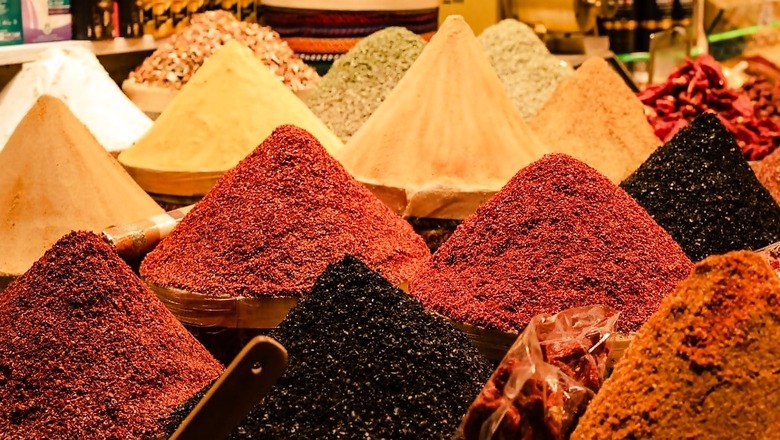
views
Spice is nice. In fact, for much of the world, it is nicer and nicer these days. Adding chilli flakes to everything from soup to pizzas is no longer an Indian obsession but an international phenomenon. The love affair that started with black pepper in Roman times has now expanded to the entire garam masala pantheon, with the five Cs—cinnamon, cloves, cardamom, coriander and cumin—now as ubiquitous as parsley, thyme, and rosemary. So why give spice a bad name and ban it?
Even if people are no longer familiar with the original idiom, there is no doubting there is a witch-hunt for Indian spices after Singapore and Hong Kong red-flagged products of two Indian brands last month because of the alleged presence of ethylene oxide (EtO). The narrative has been picked up suo motu by “concerned” authorities in other countries, including the UK, Nepal, New Zealand and Australia, though the view on the use of EtO is far from uniform around the world.
Last week, India’s food standards regulator, the Food Safety and Standards Authority of India (FSSAI) said that no trace of EtO has been found in samples of spices tested by 28 accredited Indian laboratories from the two major brands MDH and Everest that Singapore and Hongkong hauled up for alleged carcinogenic residue. The Indian products that had been targeted were MDH’s Madras Curry Powder, Curry Powder and Sambhar Masala and Everest’s Fish Curry Masala.
Fumigating spices and sterilising medical equipment are among the minor uses of EtO; it is actually widely used in the production of plastics, detergents, solvents, thickeners and organic chemicals like ethylene glycol (used for anti-freeze and polyester fibre) and other compounds. Colourless and sweet-smelling, EtO is flammable, extremely explosive carcinogenic, mutagenic and irritating at room temperatures, therefore it is usually transported as a refrigerated liquid.
Despite being a major manufacturer of EtO, European Union countries have banned it. But the US, which is a huge market for Indian masalas, allows it. In fact, the American Spice Trade Association reiterated to the Spices Board of India that EtO is approved in the US within specific limits. And Indian authorities have pointed out that international standards for ‘safe’ EtO levels vary from 0.73 per cent to 7 per cent. India has now pressed for the formulation of more uniform standards.
The Spices Board has also issued guidelines to exporters including Maximum Residue Limits and also suggested alternatives. But if EtO is not used, spices exported to the US will have a higher chance of not meeting FDA food safety standards. And according to data available up to 2022, India remains the biggest source of spices for the US at $65.2 million, followed by China ($62.5 million), Turkey ($34.3 million), Peru ($31.3 million), and Spain ($28.6 million).
Now the latest nation to sputter about the safety of Indian spices is the UK, whose Food Standards Agency (FSA) has called for “extra controls” on spices imported from India (triggered by Singapore and Hong Kong) though it has NOT found any dangerous residues. The largest source of spices for the UK is China at 22 per cent, closely followed by India at 17.7 per cent (the opposite of their ranks in the US market) with Pakistan a distant third at 7 per cent. So, who benefits from India’s spice travails?
With the world’s palate primed for “Asian” spices, the importance of India in that sphere has naturally increased. India is the largest producer of red chilli—flaked or otherwise—although Vietnam now produces roughly four times as much black pepper (the world’s most popular spice) as India. But overall, India was still the world’s top spice exporter in 2023 at $4.25 billion; so, who or what would benefit from any bans or hindrances for Indian products can easily be guessed.
Intriguingly, the main problem with imported spices in the UK is not EtO residues but adulteration, with black pepper and oregano topping the list of tampered seasonings according to an FSA report released this February. And not many know that India is one of the largest producers and exporters of oregano now, though the biggest is New Zealand. So could oregano become the next spice to be roasted by foreign authorities, causing discomfiture to Indian exporters?
Interestingly, in August 2023, the EU banned vanilla extract from the US because of EtO and demanded testing and certification before the spice was shipped. But there are no provisions for that in the US. Even more curiously, while cracking down on spices from Indian brands, the Singapore authorities’ press note added, “Although there is no immediate risk to consumption of food contaminated with low levels of ethylene oxide, long-term exposure may lead to health issues.”
According to available information, workers at facilities manufacturing or using EtO are at the highest risk; the very small levels of residue that may be found in spices or medical equipment sterilised with it carry correspondingly lower chances of serious health hazards unless there is sustained exposure. To that extent, increasing the safety levels for staff at spice sterilisation facilities certainly should be a priority for Indian exporters, in order to maintain their primacy.
That really begs the question of why Singapore and Hong Kong took such drastic action against Indian spices, whose residues (if any) would have been minimal—that is, within specified safety limits—probably caused by contact at the factory with batches heading for the US. If the move results in distrust of Indian brands, it can cause a drastic fall in exports. A definite pattern appears to be emerging.
As India maintains its overall leadership position in the spice world, and as international palates warm even more to garam masalas, new hurdles will appear periodically. India’s Spices Board has already initiated measures to deal with EtO residues (if any) but concerns will undoubtedly be raised about sustainable practices, labour standards, quality and more. Murmurs can already be heard. India has to anticipate these inevitable challenges and take steps proactively.
The author is a freelance writer. Views expressed in the above piece are personal and solely those of the author. They do not necessarily reflect News18’s views.


















Comments
0 comment